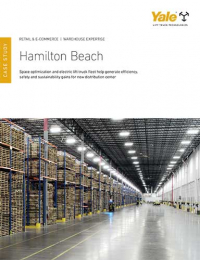Retailers navigate the omni-challenge world
Retail distribution operations turn to automation and software to support handling practices that strengthen customer loyalty.
Latest Material Handling News
Siemens, Universal Robots, and Zivid partner to unveil smart robotic picking solution AI-based inventory monitoring solution provider Gather AI raises $17 million NRF 2024 retail sales forecast calls for growth Swisslog gives live demonstration of ItemPiQ latest evolution Cimcorp automates fresh food distribution with flexible storage, order picking solutions More Inventory & PickingIt’s an omni-challenge world for today’s omni-channel retailers, who must implement the right mix of software and hardware to ensure customer retention. With so many shopping choices, retailers have to offer options—such as ship-to-home, ship-to-store, ship-from-store, buy online/pickup at store, and a range or returns choices—to compete.
Further, in pursuit of customer satisfaction, retailers feel compelled to stock items once considered seasonal in their warehouses year-round: stocking rope lights in the summer instead of just prior to the holidays, for example, in case a customer wants to purchase them for their patio décor during the warm weather months.
Then there’s the proliferation of unit-level picking, not only for individual e-commerce orders, but also to accommodate more frequent shipments of fewer, mixed- and broken-case items to replenish retail stores, while still satisfying wholesale customers with full and mixed pallet loads.
Here, we take a look at the variety of software and automated materials handling technologies retailers are implementing to address these challenges and support the handling practices that strengthen customer loyalty.
Software enables omni-channel inventory tracking for better customer experiences
Achieving a single view of inventory across multiple channels to route and orchestrate orders in an optimized way that delivers a great customer experience is among the top challenges faced by today’s retailers, according to Jim Barnes, president and CEO of enVista.
“You can’t make a promise and keep it if you don’t know where your inventory sits across your enterprise in near time, and if you don’t have confidence in the accuracy of that data,” he says. “Without that information, it’s impossible to offer the levels of omni-channel retailing that customers expect today.”
Otherwise, Barnes explains, what would prevent a customer from choosing to shop at store A versus store B? “Today’s retailers have to have the fulfillment execution systems in place that allow them to create old school service in the new age,” he says. “It goes beyond just having the perfect order.”

That’s where distributed order management (DOM) steps in, says Satish Kumar, vice president of client services and technology at Softeon. “Traditionally, retailers have an order management system and a point-of-sale system that each captures inventory information, but didn’t connect to each other or to the enterprise resource planning (ERP) system,” he explains. “Information was batch processed at the end of a given time period.”
Instead, DOM software aggregates inventory information from all possible locations—stores, warehouses, 3PLs, even inventory in-transit from a vendor—and automatically marries the inventory (guided by channel-based rules) to fill orders to individuals, retail stores, wholesalers or international partners.
“DOM can prioritize inventory allocation to fill orders for key customers or stores over individuals, for example,” Kumar adds. “If all of them have been filled by a certain time of day, then the other orders to individuals can be released automatically, without human intervention. It can also allocate against incoming inventory that has not yet been received so that the inventory is not allocated to anyone else.”
From an operational perspective, DOM enables retailers to better balance inventory and reduces their transportation and inventory carrying costs. From the customer’s perspective, DOM provides better visibility, allowing a shopper to determine if an item is available at stores within a geographic distance, or when a backordered item will be back in stock and ready to ship.
“Previously, DOM used to be primarily a back-office solution to optimize supply chain costs. Now, it’s being leveraged by sales and marketing to drive sales and customer loyalty,” Kumar adds. “For example, if marketing wants to offer a free, three-day shipping promotion, the DOM can be set up with a rule that cuts the offer off after a certain number of orders. Before, they would look at a previous pattern when developing a marketing strategy; with DOM they can react in real time.”
Software that enables inventory visibility and automatically makes allocation decisions is also key to achieving waveless picking in omni-channel retail operations, says Jay Moris,
president of Invata Intralogistics.
“Our software continuously looks at available resources—equipment, people, inventory—and assigns orders to it with the goal of moving as many pieces per hour through the building as possible,” Moris says. “There is no wave. Every time a resource becomes available, the software assigns more inventory and orders to it in milliseconds.”
For example, if the system is inducting items onto a sorter and a concealed shortage is discovered inside a master carton, the software reassigns the inventory that’s moving on the machinery to complete as many orders as possible and avoid an exceptions process, adds Walter High, vice president of marketing at Invata.
“Optimization of the distribution process allows for faster store replenishment with greater reliability,” High says, noting that this capability enables stores to schedule their labor for receiving days as needed. “It also enables immediate processing of e-commerce orders and makes more inventory available for sale faster.”
Automated systems, warehousing approaches support omni-channel fulfillment
To keep customers happy, actual stock keeping unit (SKU) counts in facilities have skyrocketed to upward of 1 million, says Mark Steinkamp, director of solutions development at Intelligrated. Having items on-hand allows a facility to fill orders to individuals, retail stores and wholesalers, even for merchandise that might be out of season.
“Retailers’ warehouses now have to stock Christmas lights year-round because someone might want them for a party in April,” he explains. “To keep that customer, you’ll offer it through your Website.”
To manage this profusion of inventory, operations are implementing a variety of materials handling equipment, both automated and non-automated, to store it all.
“For approximately 60% of SKUs, automated goods-to-person shuttle systems are ideal because they provide high-density storage and bring the product to the picker,” Steinkamp explains. “The fastest 5% to 10% goes into forward pick modules, and the remaining 30% or so are now being stored in random bin-pick modules that provide very dense storage for low-volume SKUs.”
And, as labor continues to be a challenge, retailers are looking into robotic picking of eaches, a technology Steinkamp thinks will be more common within the next three to five years.
“For operations that handle similar form factors—bagged apparel at a fashion retailer, for example—it’s easy to match a robot to that application because a single end effector or gripper can be used to pick an item from a bin,” he says. “Big box retailers that handle a broad range of items, from cell phone cases to lip balm to apparel to electronics, are more likely to utilize robots that follow a picker down the aisle to deliver empty order picking bins and take away completed orders or batch-picked containers.”
Steinkamp also sees more retailers looking to centralize all of their break-pack retail operations into a single facility, rather than doing so at every DC, to accommodate the more frequent shipments of mixed case items to stores. That same facility can also be used to handle a seasonal peak in online ordering, which typically hits around Black Friday/Cyber Monday, he says.
“It’s a mixed-use, high-volume facility that balances the workload between breaking down pallets into case-level shipments to fulfill retail stores 300 days out of the year, and then, for the two months in advance of the peak retail season, it’s converted to individual order fulfillment,” Steinkamp explains. “That dual usage enables the payback. They make an investment to handle their peak e-commerce season, but then use the same equipment for the rest of the year to process eaches for retail store replenishment.”
Also deployed to handle multi-channel fulfillment with eaches, pocket (or pouch) sorters consist of multiple carriers, each outfitted with a single pouch hanging beneath. The carriers travel over rollers on rails mounted overhead, maximizing the cube of a facility. Soft and flexible, each pouch handles single units weighing up to 10 pounds, says Krish Nathan, CEO of SDI Systems.
“We’re seeing a convergence of the order characteristics between e-commerce orders and retail store replenishment in that the size of the order to a retail store is shrinking to less-than-case handling because the stores don’t want to carry inventory,” Nathan explains. “That trend makes this technology ideal for retailers who have multi-channel operations because it handles items at the unit level.”
Each pouch is individually identified and controlled for movement into buffer loops or storage lanes as needed. To build orders—whether they are to an individual, a retail store or a wholesaler—the pouch sorter’s control software uses algorithms to determine which items belong to an e-commerce or store replenishment order, then routes the appropriate pouches to a packer at a workstation.
“As a goods-to-person system, the sorters eliminate the walking and travel time for an operator to go retrieve the required units that may be stored on different sides of the warehouse,” Nathan continues. “Further, the systems are high-speed, handling up to 10,000 pouches per hour.”

Article Topics
Inventory & Picking News & Resources
Siemens, Universal Robots, and Zivid partner to unveil smart robotic picking solution AI-based inventory monitoring solution provider Gather AI raises $17 million NRF 2024 retail sales forecast calls for growth Swisslog gives live demonstration of ItemPiQ latest evolution Cimcorp automates fresh food distribution with flexible storage, order picking solutions ABCO Systems acquires FastFetch The Ultimate Guide to Reducing Warehouse Travel More Inventory & PickingLatest in Materials Handling
Lucas Watson appointed CSO for Körber’s Parcel Logistics business in North America Hyster recognizes Dealers of Distinction for 2023 Carolina Handling names Joe Perkins as COO C-suite Interview with Keith Moore, CEO, AutoScheduler.AI: MODEX was a meeting place for innovation Walmart deploying autonomous lift trucks at four of its high-tech DCs Coles shops big for automation Kathleen Phelps to join FORTNA as chief financial officer More Materials HandlingAbout the Author
Subscribe to Materials Handling Magazine

Find out what the world's most innovative companies are doing to improve productivity in their plants and distribution centers.
Start your FREE subscription today.
April 2024 Modern Materials Handling

Latest Resources











